The Oligocene is a geologic epoch of the Paleogene Period and extends from about 33.9 million to 23 million years before the present. As with other older geologic periods, the rock beds that define the epoch are well identified but the exact dates of the start and end of the epoch are slightly uncertain. The name Oligocene was coined in 1854 by the German paleontologist Heinrich Ernst Beyrich from his studies of marine beds in Belgium and Germany. The name comes from the Ancient Greek ὀλίγος and καινός, and refers to the sparsity of extant forms of molluscs. The Oligocene is preceded by the Eocene Epoch and is followed by the Miocene Epoch. The Oligocene is the third and final epoch of the Paleogene Period.
Lampriformes is an order of ray-finned fish. Members are collectively called lamprids or lampriforms, and unite such open-ocean and partially deep-sea Teleostei as the crestfishes, oarfish, opahs, and ribbonfishes. A synonym for this order is Allotriognathi, while an often-seen, but apparently incorrect, spelling variant is Lampridiformes. They contain seven extant families which are generally small but highly distinct, and a mere 12 lampriform genera with some 20 species altogether are recognized. They are the only extant members of the superorder Lamprimorpha, which was formerly diverse throughout much of the Late Cretaceous.

Goosefishes, sometimes called anglers or monkfishes, are a family, the Lophiidae, of marine ray-finned fishes belonging to the order Lophiiformes, the anglerfishes. These fishes are found in all the world's oceans except for the Antarctic Ocean.
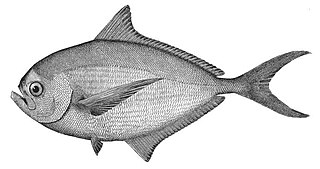
Pomfrets are perciform fish belonging to the family Bramidae. The family currently includes 20 species across seven genera. Several species are important food sources for humans, especially Brama brama in South Asia. The earlier form of the pomfret's name was "pamflet", a word which probably ultimately comes from Portuguese pampo, referring to various fish such as the blue butterfish. The fish meat is white in color.

Zebrasoma is a genus of marine ray-finned fishes belonging to the family Acanthuridae which includes the surgeonfishes, unicornfishes and tangs. These fishes are found in the Indo-Pacific region.

Archaeus is an extinct genus of marine jackfish from the Paleogene of Europe, where it inhabited the former Tethys Ocean. The oldest species, A. oblongus is from the early Ypresian epoch of Eocene Turkmenistan, and the last species, A. glarisianus and A. solus, are from the early to middle Rupelian, of the Oligocene lagerstatten of Canton Glarus, Switzerland and the Pshekha Formation of North Caucasus, Russia.

Crestfishes, family Lophotidae, are lampriform fishes found in most oceans. It consists of two extant and four extinct genera.

Scomber is a genus of fish in the family Scombridae living in the open ocean found in Atlantic, Indian and Pacific Ocean. The genus Scomber and the genus Rastrelliger comprise the tribe Scombrini, known as the "true mackerels". These fishes have an elongated body, highly streamlined, muscular and agile. The eyes are large, the head is elongated, with a big mouth provided with teeth. They have two dorsal triangular fins, with some stabilizing fins along the caudal peduncle. The basic color is blue-green with a silvery white belly and a darker back, usually black mottled.
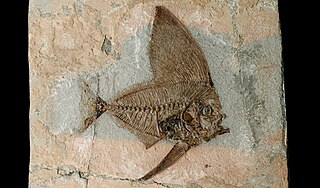
Exellia is a genus of extinct spadefish that lived in the Tethys Ocean during the early Paleogene. The adult form is shaped akin to a large spadefish or a short dolphinfish, with very large pelvic fins, and a long dorsal fin starting from in front of the eyes to near the base of the caudal peduncle. The juvenile form resembles a juvenile drumfish, with the dorsal fin forming a long crest on top of the head.
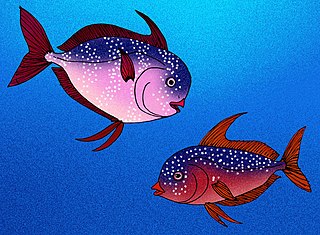
Turkmenidae is an extinct family of lamprids from the Paleogene of the west-central Asia, in what was formerly the Peri-Tethys Ocean. They were small, disk-shaped fish that bore a strong resemblance to their closest living relatives, the opahs.
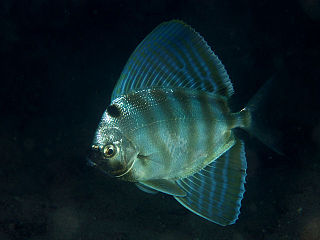
Velifer hypselopterus, the sailfin velifer, is an Indo-Pacific velifer. This species grows to a length of 40 centimetres (16 in) TL. This species, like the other one in the family Veliferidae, is monotypic in its genus. It is of minor importance in commercial fisheries.

Caranx is a genus of tropical to subtropical marine fishes in the jack family Carangidae, commonly known as jacks, trevallies and kingfishes. They are moderate- to large-sized, deep-bodied fishes which are distinguished from other carangid genera by specific gill raker, fin ray and dentition characteristics. The genus is represented in the Pacific, Indian and Atlantic Oceans, inhabiting both inshore and offshore regions, ranging from estuaries and bays to deep reefs and offshore islands. All species are powerful predators, taking a variety of fish, crustaceans and cephalopods, while they in turn are prey to larger pelagic fishes and sharks. A number of fish in the genus have a reputation as powerful gamefish and are highly sought by anglers. They often make up high amounts of the catch in various fisheries, but are generally considered poor to fair table fishes.

The sailfin tang, the Pacific sailfin tang, purple sailfinned tang or sailfin surgeonfish, is a marine ray-finned fish belonging to the family Acanthuridae which includes the surgeonfishes, unicornfishes and tangs. This fish is found in the Pacific Ocean and is popular in the aquarium hobby.
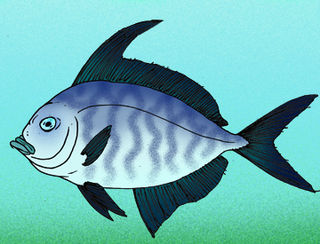
Veronavelifer sorbinii is an extinct sailfin moonfish from the Lutetian epoch of the Monte Bolca lagerstatten.
Oligolophotes is an extinct genus of fish from the Early Oligocene of the bank of Belaya River in Adygea, the Caucasus Mountains. There is one species, Oligolophotes fragosus, known from the holotype that is estimated to have measured 122 mm (4.8 in) in body length.
Berycomorus is an extinct genus of prehistoric marine ray-finned fish that lived during the late Eocene epoch. It contains a single species, B. firdoussi, from the Pabdeh Formation of Iran.
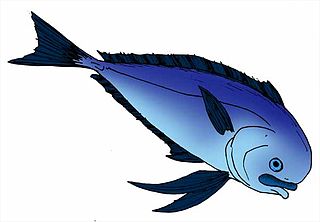
Aluvarus praeimperialis is an extinct ray-finned fish, known from two headless fossil specimens found in the Pabdeh Formation, a Late Eocene stratum from the Priabonian epoch, of what is now Iran. A. praeimperialis was originally thought to be a luvar, described as "Luvarus praeimperialis", as it was thought to be a predecessor to the modern luvar. A later reexamination of the specimens showed that they were too incomplete to demonstrate such a conclusion and had no clear exclusive shared traits with luvar, and were renamed "Aluvarus", meaning "not luvar" or "different than luvar". However, some authorities still retain it as a luvar.

An anchovy is a small, common forage fish of the family Engraulidae. Most species are found in marine waters, but several will enter brackish water, and some in South America are restricted to fresh water.
Microlipophrys velifer, the sailfin blenny is a species of combtooth blenny found in the eastern Atlantic ocean off west Africa from Mauritania and Cape Verde to the Cunene River, Angola.
This list of fossil fish described in 2018 is a list of new taxa of jawless vertebrates, placoderms, acanthodians, fossil cartilaginous fish, bony fish, and other fish of every kind that are scheduled to be described during the year 2018, as well as other significant discoveries and events related to paleontology of fish that are scheduled to occur in 2018.














